What is a differential automaton (difavtomat)?
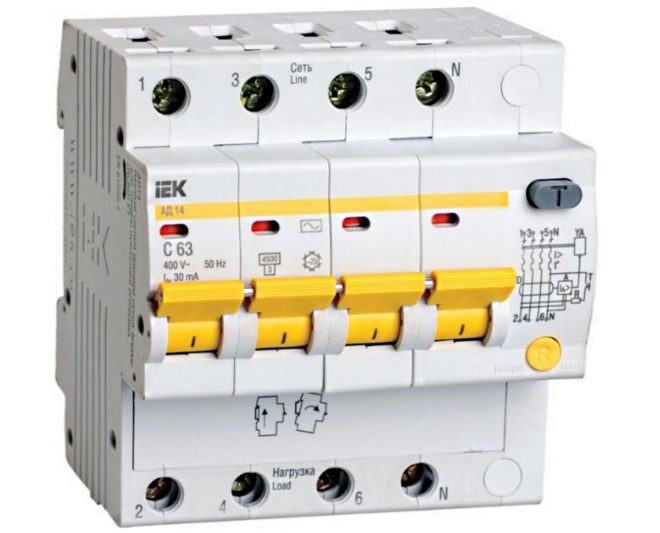
A device designed to turn off the power supply in the network when violations appear in it that can lead to failure of the wiring and the equipment connected to it, in an electrician is called an automatic switch (AB). This device is usually called more simply - an automatic machine. One of its varieties is a residual current device that de-energizes the line when a leakage current is detected, thereby preventing people from being shocked by electricity when they touch the cable. The peculiarity of the RCD is such that it cannot be installed without an AB, which protects the line from short-circuit and overvoltage. In order not to connect two protective devices to the line, a differential automatic was created - a device that combines the functions of an RCD and a circuit breaker.
Content
Features and purpose of the difavtomat
If almost everyone knows about ordinary electrical machines, then when they hear the word "difavtomat", many will ask: "And what is this?" In simple terms, a differential circuit breaker is a circuit protection device that cuts off the power in the event of any malfunction that could damage the line or shock people.
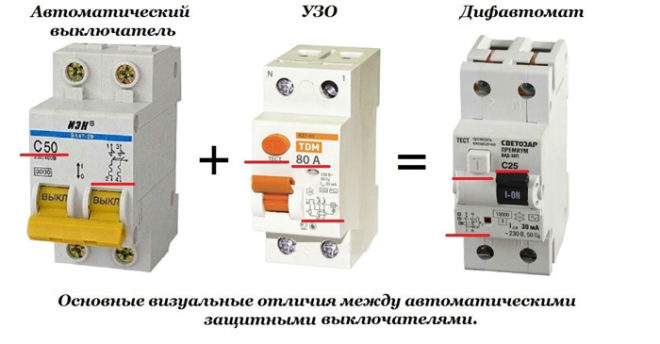
The apparatus consists of several main parts:
- Melting and fire resistant plastic housing.
- One or two levers for feed and power off.
- Marked terminals to which incoming and outgoing cables are connected.
- "Test" button, designed to check the device's serviceability.
In the latest models of these machines, a signal indicator is also installed, which makes it possible to differentiate the reasons for the operation. Thanks to him, you can determine why the device has turned off - due to current leakage or due to line overload. This function makes troubleshooting easier.
Clearly about the device of the difavtomat in the video:
The residual current circuit breakers can be installed in both single-phase and three-phase lines. They are intended for:
- Protection of the power grid against short-circuit overcurrents and overvoltage.
- Preventing electrical leakage that could result in fire or electric shock to people and pets.
A differential current switch for household lines with one phase and an operating voltage of 220V has two poles. In industrial networks for 380V, a three-phase four-pole differential automatic is installed. Quadrupoles take up more space in the switchboard, since a differential protection unit is installed with them.
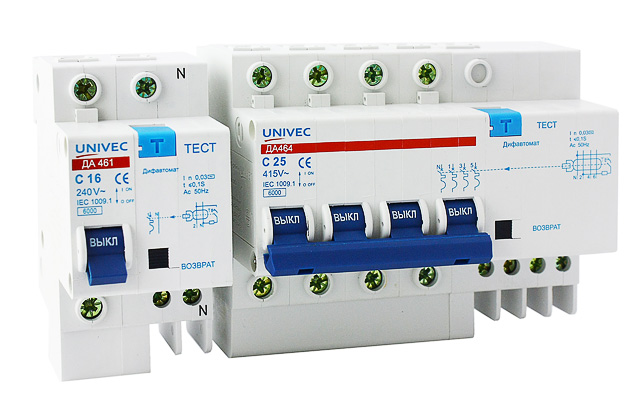
The appearance of the difavtomat
When looking at the RCD and differential AB, you can see that they are very similar in design and size. There is even a "Test" button on both devices. But this does not mean that they are completely the same. The residual current device is not an independent device and should not, as mentioned above, be installed in a circuit without a protective circuit breaker. The differential automatic machine combines RCD and AV, therefore, it does not need to install additional devices.
In order not to confuse an RCD and a differential protection switch, most domestic manufacturers mark their products with the corresponding abbreviation - RCD or RCBO. Imported appliances can be distinguished in other ways. For example, the current rating of the residual current device is indicated by a number and the letter "A" (Ampere) after it - for example, 16A.The current rating of the difavtomat is written differently: in front of it is a Latin letter corresponding to the characteristics of the built-in releases. After it comes a number indicating the value of the rated current - for example, C16.
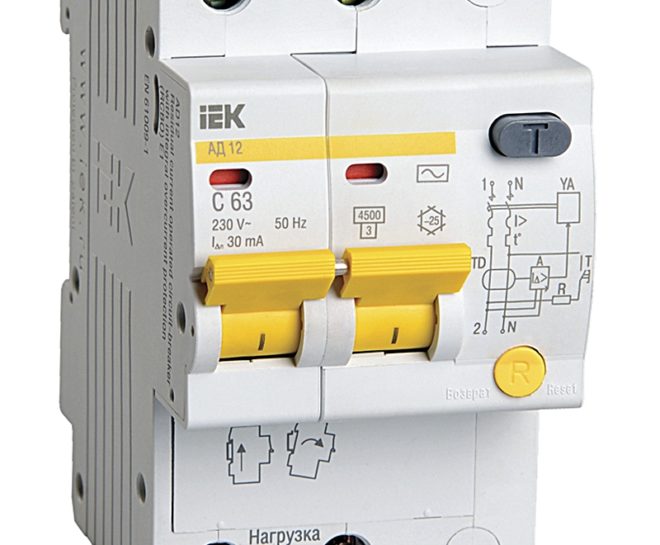
Differential AV operation with electric current leaks
Leakage protection is provided by the relay included in the difavtomat. When the parameters of the line are normal, uniform magnetic fluxes act on it, and the element does not interfere with the supply of current to consumers. When the insulating layer breaks down, a leak occurs, as a result of which the uniformity of the flows is disturbed, and the relay triggers the machine.
Overload and short circuit protection
Now let's talk about how the differential circuit breaker works when a short circuit occurs in the circuit and with a significant increase in voltage. In these cases, its principle of operation is similar to that by which a conventional circuit breaker functions.
The RCBO has two releases that operate independently of each other. Each of them is designed to de-energize the network in the event of various violations.
In the video, the internal structure of the difavtomat:
Line overload protection is provided by a thermal release, the role of which is played by a plate of two metals with different expansion coefficients (bimetallic).
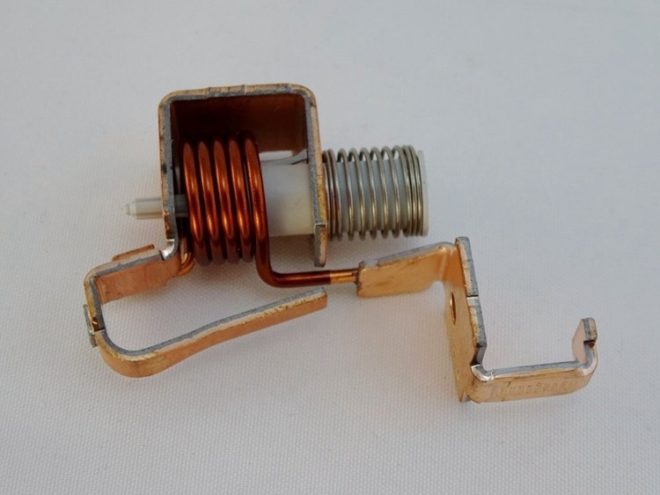
When the voltage in the circuit exceeds the nominal value, the plate begins to heat up, which leads to its bending towards the tripping element. By touching it, it triggers AB.
The network is protected from short-circuit overcurrents by an electromagnetic release, which is a solenoid with a core. With a sharp increase in the current strength characteristic of a short circuit, an electromagnetic pulse arises. Under its influence, within a fraction of a second, the release will trip the circuit breaker and cut off the power supply to the line.
When the fault has been rectified, the device can be switched on again manually. However, it should be remembered that if the network parameters returned to normal very quickly after disconnecting the AV, the device should be given a little time to cool down completely. Turning on a heated apparatus will negatively affect its service life.
Installation procedure
The RCBO is mounted on a DIN rail. When connecting, you need to be very careful not to mix up the order of connecting the cables. In household single-phase lines, the input conductor is connected to terminal number 1, and the output conductor is inserted into terminal number 2. The neutral wire is connected to the terminal marked with the letter N. Input cables are connected to the top of the device, and the output cables to the bottom.
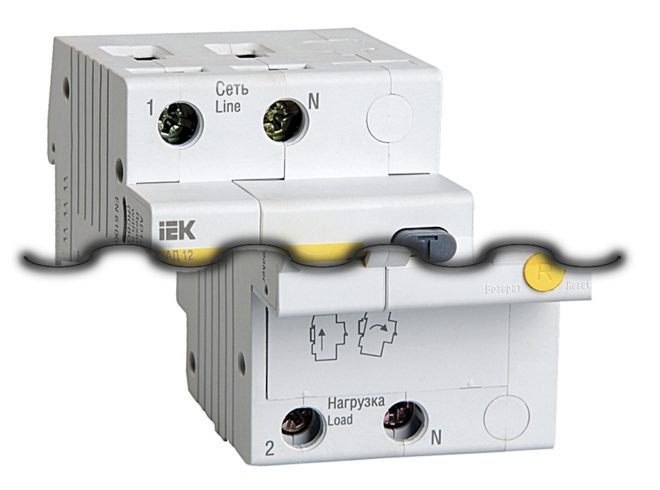
You can connect outputs directly to the line. If the network parameters are not stable, or you want to provide the highest level of protection, you should install additional AV.
Neutral wires from the machines must be connected to an insulated zero bus. In order to avoid the failure of the device or its incorrect operation, it is necessary to ensure that the output zero cable does not come into contact with other conductors or with the housing of the electrical panel.
Clearly about connecting a difavtomat in the video:
Grounding RCBO
The neutral cable should only be grounded in front of the differential protection device. Incorrect connection will lead to the fact that the difavtomat will turn off even when a small load is applied.
If several differential automata are connected in parallel, then it is impossible to swap neutral conductors at their outputs or connect them to a common zero bus. It will also cause the devices to malfunction.
Zero RCBO must be connected in tandem with its own phase. It cannot be used as a neutral conductor for devices with a different phase source.
To avoid confusing zeros, it is recommended to use labeled cables.
For jumpers and connections, you must use a conductor with a cross section suitable for the line load.
If the machine is equipped with a malfunction indicator, then the reason for the operation will be clear immediately. In the absence of a "beacon", the cause of the failure will have to be looked for by the "scientific poke" method. If the RCBO starts to operate after connecting an additional load to the network, then, most likely, the device is faulty or an error was made when connecting it.
Conclusion
In this article, we talked about what a difavtomat is, what it is for and how it works, and also figured out the important nuances of its connection. If you are going to install the RCBO yourself, before that, carefully study the installation procedure, and strictly observe safety precautions during operation.





